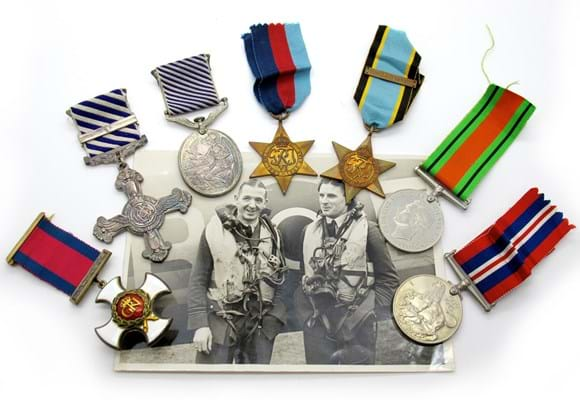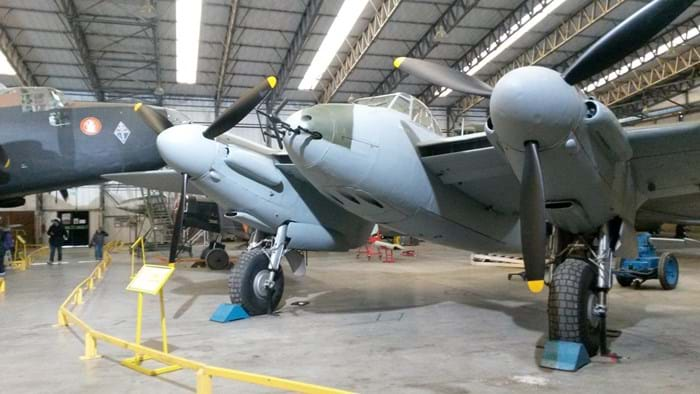British Bomber Command crews suffered 55,573 dead – a huge 44.4% rate considering the 125,000 aircrew involved. The death rate was higher than any other for the British armed forces during the conflict.
A total of 30 RAF operational flights was considered outstanding, so what about a man who completed 145 operational sorties as both a pilot and navigator?
Squadron Leader Sydney Clayton DSO, DFC and Bar, DFM, achieved that incredible feat, and on January 26 Sheffield Auction Gallery is offering his medals and RAF archive in the first of its live internet medals and militaria auctions this year. The estimate is £10,000-15,000.
The Lancashire-born Clayton had various jobs before the outbreak of war including that of a commercial traveller, selling cheese for a local company, before signing up for the RAF in May 1939.
Although ambitious to be a pilot, such training was oversubscribed so he turned his talents to training as a navigator. Qualifying in 1940, his first operational unit was 107 Squadron flying the Blenheim light bombers, mainly on daylight raids. In total Clayton flew 72 operational sorties in the Blenheim, resulting in the awarding of a Distinguished Flying Medal in spring 1941 for completing 60 sorties and promotion to flying officer.
Back to active duty
Following a period on instructional duties, with the formation of the first De Havilland Mosquito squadrons in early 1942, Clayton returned to active duty with 105 Squadron. His first operational flight was on July 11, 1942, with a low-level bombing raid on the submarine base at Flensburg. Badly damaged by flak, the plane was forced to ‘belly land’ at 160mph on its return.
On October 21, 1942, while crossing the Dutch coast, Clayton’s Mosquito was attacked by two German Focke Wulf 190s. Following a 15-minute encounter the Mosquito escaped, and for his role as navigator in this encounter Clayton was awarded the Distinguished Flying Cross. Then, on December 9, Clayton was navigator in a famous bombing raid when, along with pilot Wing Commander Roy Ralston, they trapped a German train while in a tunnel near Paris.
Clayton continued to fly both high and low-level raids until March 1943, often with his constant companion Ralston as his pilot, hitting communication and logistical targets including the Renault Aero Works at Le Mans. On April 1, 1943, a low-level raid on the Trier railway engine repair depot was to be Clayton's 100th operational sortie and last as a navigator. A Distinguished Service Order followed, with many plaudits including a telegram from Air Marshal Sir Arthur ‘Bomber’ Harris and a picture and plaque from De Havilland itself.
Pilot training
It was now that Clayton’s original ambition was to be fulfilled and pilot training began. By May 1944 he was flying Mosquitos solo, with his first flight being remembered for having to land on one engine after a technical failure. With pilot wings gained, Clayton was posted to 464 Squadron RAAF and began flying Mosquitos operationally on August 26, 1944.
On October 31, 1944, in a daylight raid Clayton was involved in one of his most memorable raids with the attack on the Gestapo Headquarters in Aarhus, Copenhagen, in support of the Danish Resistance. For this, he received a pair of ‘royal’ cufflinks from the resistance and the action formed part of the citation for a Bar to his DFC. A letter from the resistance and the cufflinks form part of the collection being auctioned.
Having completed 145 operational flights, 100 as a navigator and 45 as a pilot, on his return to civilian life Clayton was back in Lancashire running a hotel and a newsagents, before joining the civil service in 1971. He died five years later.
Humble man
A humble man, Clayton once said of his flying days: “Apart from the odd bit of flak or an encounter with a night fighter, nothing terribly exciting happened in my ops as a pilot.”
The medals are being sold by his family to fund a permanent memorial to Clayton and, as part of the pre-auction publicity, the medals, family and a De Havilland Mosquito were all united at the RAF Museum in Hendon earlier this month.









